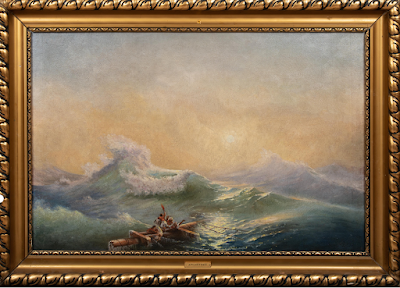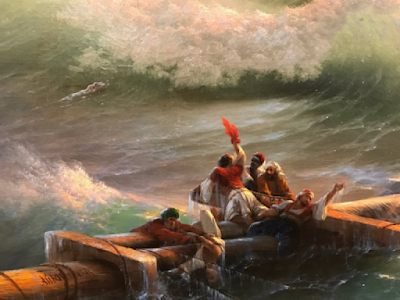Waves in 19th Century Art: The Epic “Ninth Wave” by Ivan Aivazovsky
“The Ninth Wave” is a stunning Romantic seascape. It was painted by one of the most famous marine artists in the history of art. Ivan Aivazovsky was an Armenian painter, who lived and worked in the Russian Empire, creating over 6,000 seascapes during his lifetime.
“The Ninth
Wave”. 1850. Ivan Konstantinovich Aivazovsky
Who Was Aivazovsky?
Ivan Konstantinovich Aivazovsky (1817-1900), was one of the most famous painters of the Russian Romanticism. He was Armenian, born Hovhannes Aivazian, and he grew up in the Black Sea port of Feodosia, Crimea. Aivazovsky became one of the leading marine painters of the 19th century. His amazingly vivid seascapes made his hometown Feodosia famous across the Russian Empire and beyond. In fact, he was one of the rare Russian painters to have an exhibition in London in 1881.
After completing his education in St Petersburg, Aivazovsky travelled all over Europe, including Italy. He was later appointed the official painter of the Russian Navy, creating paintings of its flagships as well as numerous seascapes with sea battles and navy parades. But while giving him financial stability and an official position at the Russian court, these paintings weren’t the ones he’s still remembered for.
The Stormy Masterpiece
“The Ninth Wave” by Ivan Aivazovsky shows the survivors of a shipwreck clinging to a raft composed of the wreckage of their ship in the middle of a turbulent sea. The title of the painting refers to the sailor lore belief that every ninth wave is a giant wave, higher and more powerful than the others[1]. That’s the large wave depicted on the left side of the painting. The artist shows the exact moment when the wave is about to break, luckily passing by the survivors on the raft.
The survivors of the shipwreck are in a dangerous position, held afloat by their raft, which seems fragile amid the raging waves. Nevertheless, the retreating clouds in the dawn sky give hope that perhaps the worst of their trials are over.
Allegorical Meaning Behind the Ninth Wave
It’s not known for certain whether Aivazovsky implied any allegorical meaning in his painting. Most of his paintings are realistic and depict moments actually witnessed by Aivazovsky himself. “The Ninth Wave” is not an exception. The painting was likely inspired by one of the episodes of a storm that Aivazovsky was caught in when travelling on a ship in the Bay of Biscay. The raging sea was probably painted from memory since Aivazovsky was known for often relying on memory instead of sketches to paint his seascapes. This doesn’t mean, of course, that his works are journalistic representations of real events.
It’s definite that the painting shows a struggle between men and the forces of nature, which was one of the favourite themes in the art of Romanticism. The power of the sea is a recurring theme in Aivazovsky’s art, and he would have known all about it, too, growing up in a seaside town, where sailors, fishermen, merchants, smugglers, and navy officers mingled at the docks.
Some art
historians find Christian themes in the painting, as the raft resembles the
cross in shape, with people clinging to it for salvation from the storms of sin
and death. The dawn is often associated with salvation in the Bible as well. While Aivazovsky painted many religious works, it's not certain that he meant any message in this particular painting. One thing is definite - the painting inspires awe, but also has an uplifting message of hope that differentiates it from other stormy seascapes painted by the artist.
Interesting Facts About “The Ninth Wave”
- Aivazovsky’s masterpiece is a huge painting; it measures 11 feet (3.3 meters) by 7 feet (2.2 meters).
- “The Ninth Wave” was acquired by Emperor Nicholas I for the Russian Imperial collection of art at the Hermitage, St Petersburg. Before that happened, however, Aivazovsky was arranging for the sale of the painting with Pavel Tretyakov, an avid art collector and founder of the Tretyakov Gallery in Moscow.
- “The Ninth Wave” drew crowds of people when it was first exhibited in 1850. One of the people who saw the painting was the young Ivan Ivanovich Shishkin, who became one of the most famous Russian landscape painters.
- It’s believed that “The Ninth Wave” depicts a rogue wave. Once considered a tale from sailors’ lore or an extremely rare occurrence, scientists now acknowledge that rogue waves are a relatively frequent cause of shipwrecks.
Paintings by Aivazovsky: (from upper left to right) "Daryal Gorge", "View of Moscow from Sparrow Hills", "Winter landscape", "Jesus walks on water", and "Travel of Poseidon by sea"
- Aivazovsky was the acknowledged master of seascape art, but he didn’t exclusively paint the sea. He painted the mountains of Caucasus, Moscow’s suburbs, numerous snowy landscapes, as well as mythological and religious subjects.
- Another of Aivazovsky’s paintings, “View of Constantinople and the Bosphorus” was sold for $5,2 million at Sotheby’s in 2012.
Aivazovsky’s skill in showing the sea in all of its shifting moods and masterful compositions established his place among the best marine artists in the world. Because of its sheer splendour and stunning play of light on the sea surface, “The Ninth Wave” is considered his masterpiece.
Further Reading:
https://www.theartstory.org/artist/aivazovsky-ivan/
https://www.metmuseum.org/art/collection/search/286403
Иван Айвазовский. К 200-летию со дня рождения. Государственная Третьяковская галерея, 2016 ISBN: 978-5-89580-132-1









Comments
Post a Comment